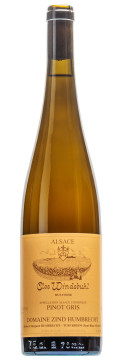
Technical presentation
| Bottling : | January 2022 |
|---|---|
| Acquired alcohol : | 13.5° |
| Residual sugar : | 2 g/l |
| Total acidity : | 4.8 g/l H2SO4 (7.3 g/l Acide Tartrique) |
| pH : | 3.2 |
| Yield : | 35 hl/ha |
| Optimum tasting : | 2026-2040+ |
| Average age of vines : | 51 years |
| Grape variety : | Pinot Gris |
| Terroir : | Clos Windsbuhl |
| Sweetness index : | 1 |
| Soil : | Medium slope, Muschelkalk calcareous, South East facing, South facing |
Description of the wine Pinot Gris Clos Windsbuhl 2020
The Clos Windsbuhl enjoys a late ripening location due to its altitude and proximity of the Vosges mountains, which is why grape varieties such as Pinot-Gris were favoured in the past and still today represent the most planted grape variety on the Clos. Like on many other terroirs, the ripening of the grapes is influenced by the current climate change: the vintages are earlier and the harvest takes place more early/mid-September than mid-October or later. In fact, this development is very favourable to obtaining dry wines because botrytis (noble rot) is becoming increasingly rare. Pinot-Gris ripens more slowly on the Windsbuhl, so it can keep a remarkable acidity and becomes a drier wine, as in 2020. Determining the harvest date is, however, very difficult for this grape variety and such precision requires daily maturity checks as the harvest approaches. In 2020, the grapes were very healthy, the fermentation was slow, very slow, but eventually the wine was able to finish completely dry to our great satisfaction. The bottling took place after aging for 17 months in old oak foudres and on total lees.

Tasting notes
01/2022 : Bright pale yellow colour. The nose expresses all the delicacy of the Windsbuhl with aromas of white fruits and especially citrus fruits (lemon, bergamot). Still on its reserve, almost austere, it will need time to evolve in the bottle, an evolution that a simple decantation in a carafe cannot replace! On the palate, the wine shows a crazy energy and tension based on the acidity typical of this cru. The limestone brings a salivating touch to the finish and completely transcends this grape variety which gives way to the Windsbuhl precision also discretely hiding its power.

The Clos Windsbuhl of Hunawihr
The altitude of the vineyard coupled with Hunawihr’s tardy climate means that the Clos Windsbuhl is often one of the last of our vineyards to be harvested. This explains the aromatic quality of the Clos’ wines and the consistent balance of acidity, a guarantee of good ageing. Although often harvested late, the Windsbuhl grapes are only rarely botryitized, doubtless due to the altitude of the vineyard, but nevertheless often reach high levels of maturity.